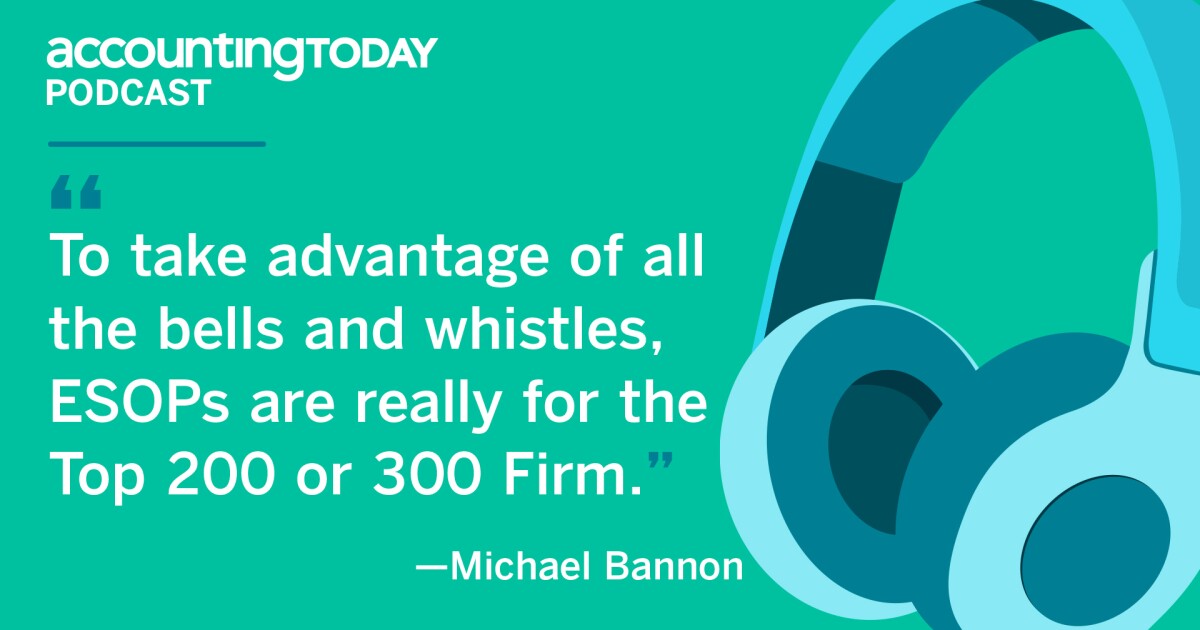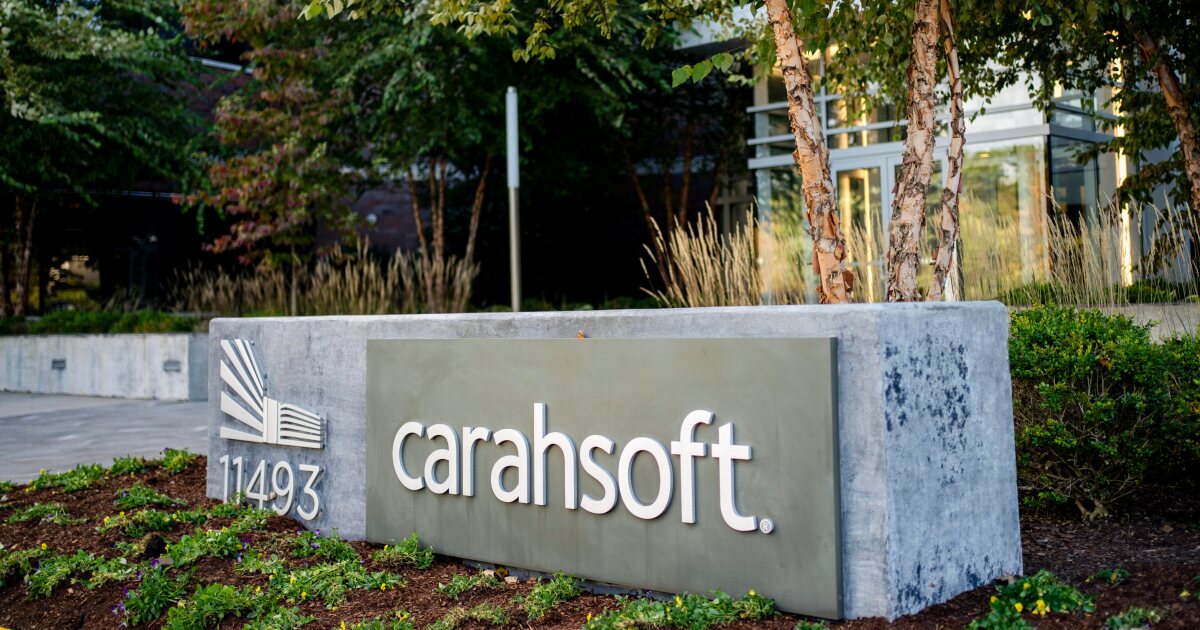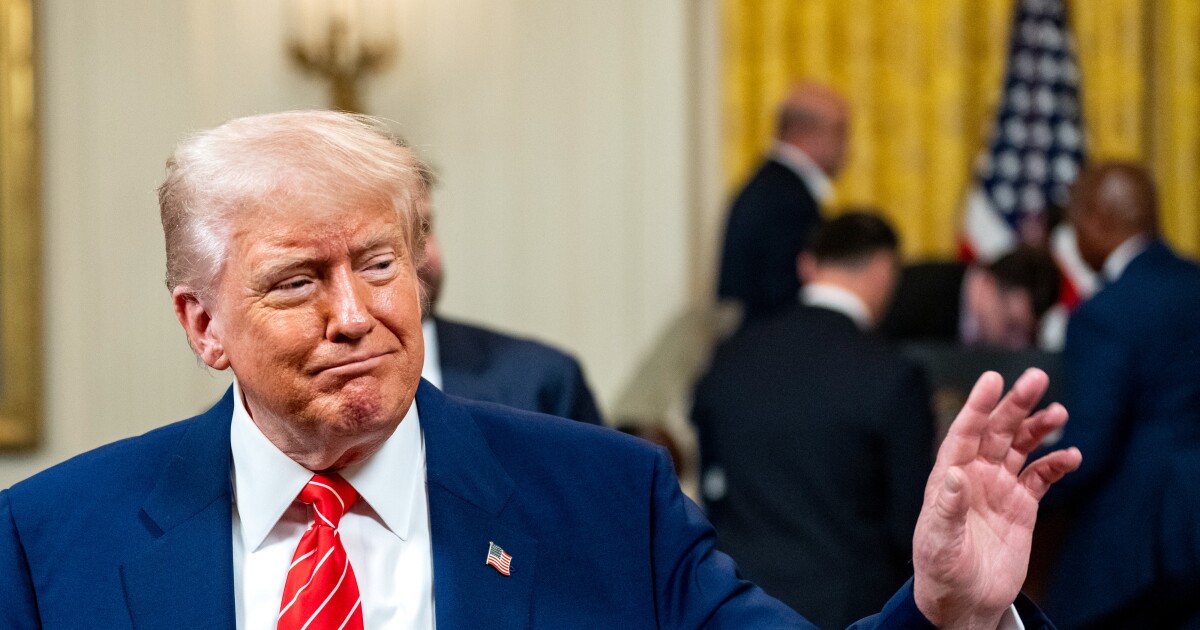Accounting
All about ESOPs | Accounting Today
Published
8 months agoon


Michael Bannon of ESOP investment banking advisors CSG Partners explains which accounting firms might want to look into employee stock ownership plans — and why.
Transcription:
Transcripts are generated using a combination of speech recognition software and human transcribers, and may contain errors. Please check the corresponding audio for the authoritative record.
Dan Hood (00:04):
Welcome to On the Air With Accounting. Today I’m editor-in-chief Dan Hood. More and more accounting firms are exploring different structures, from private equity ownership to selling to wealth management firms to the subject of today’s episode, which is creating an ESOP. Now, ESOPs have been around for quite a while, but the accounting profession hasn’t shown that much interest in them before now. And here to talk about why that maybe should change and what ESOPs are all about is Michael Bannon. He’s a vice president at ESOP, investment banking advisors CSG Partners. Michael, thanks for joining us.
Michael Bannon (00:30):
Yeah, thanks for having me, Dan. Excited to get started and talk about the ESOPs and accounting industry.
Dan Hood (00:35):
Yeah, this, I won’t say it’s new. As I said, they’ve been around for decades, but I think interest in them in accounting has skyrocketed Recently, there’ve been a couple of big deals or big firms that have adapted them. Grassy and obviously BDO both made big headlines with that. But I think maybe we’ll start sort of simple. I’ve just been saying blindly saying ESOPs and throwing that word around us. If everyone knows what it means, I think most people do, but maybe we should dive a little bit into it and give us a good description of what an ESOP is.
Michael Bannon (01:04):
Yeah, sure. So ESOP is an acronym stands for Employee Stock Ownership Plan. Technically speaking, an ESOP is a qualified retirement plan that allows employees or eligible employees to earn stock in the companies they work for. So in the accounting industry, your rank and file staff, your professionals would earn stock in your firm over time. Functionally speaking. The way that we at CSG think about ESOPs is really it’s a tax advantage or self-directed leverage buyout of your firm. And so it can be used from a number of different tools, whether succession planning, liquidity strategy, a platform for growth, et cetera. It’s a lot of different ways to use that tool.
Dan Hood (01:49):
Cool. You said tax advantage, I think set Seth Ho of fire across the accounting audience states. They love to hear anything to do with tax advantages, but maybe let’s, before we dive into that aspect of things, talk a little bit about can any company become any esop? Are there any restrictions in terms size or business structure or type of business?
Michael Bannon (02:08):
Yeah, so in general, I’d say from a size perspective, when you’re talking about accounting firms, probably top 200 or 300 firms are probably best positioned to benefit from all of the benefits of an esop. Certainly if you’re top 500, you can also do an esop, but it does come with ongoing administrative costs and some expenses to set it up. So in order to take advantage of all the bells and whistles, really that 200, 300 size firm in terms of partnership structure, you can do it for a closely held partnership, broadly held partnership. There are some restrictions on what kind of entity can be sold to an esop. It must be a corporation. So if you’re currently a partnership, either an LP or LLC, you do have to incorporate and sell stock of either a C corporation, rests corporation to the ESOP directly. And as many of your listeners know, there’s a lot of different steps to create reorganizations, a lot of fun puzzles to do in order to complete that. Right.
Dan Hood (03:13):
Well, I think accounting trends may be more familiar with the notion of structure that a lot of other businesses, but really what they know is they know it’s difficult to go through all those steps and to reorganize. But I think what, since we’re talking about the partnership structure, let’s dive into a little bit into that a little bit because for a lot of accounting firms, they’re built as, they’re set up as partnerships, and a lot of their partners have equity and so on, and that obviously they’re going to want to understand how that impacts their equity. What does it mean? Are they selling their equity to the new corporate structure? How does that generally play out?
Michael Bannon (03:46):
Yeah, so generally speaking, the structure of an ESOP is very flexible, but is really based off of similar transaction structure as a private equity sale. So if you have a traditional partnership where you basically zero out the net income each year through the comp formula, you’re going to have to adjust your compensation formula to create retained earnings. And basically that retained earnings is the basis of the value that you’re going to be selling to the esop, just like it would be the basis of earnings you’d be selling to a private equity firm. The difference here, and we’ll touch on the tax benefits, is that those retained earnings and the equity that is being sold, all of that is staying in house, right? You don’t have a third party investor from, for example, private equity fund or a merger with another accounting firm. All of that equity goes into a trust employee, stock ownership trust that the beneficiaries of that trust are all of your eligible employees. So basically you’re selling equity, but it all stays within the family, so to speak.
Dan Hood (04:48):
Gotcha. I mean, this may be a wild oversimplification because I am neither an accountant nor a tax expert. I just talked to ’em all day. Does that mean that basically when the employees become eligible, they become part of that trust? Is that how their ownership works?
Michael Bannon (05:02):
They become beneficiaries of the trust, and so each of those employees has their own individual account, and over a long period of time, stock starts being allocated into their individual accounts. And then ultimately, once they retire, they’re able to, of course, as the stock is allocated, it’s tax deferred when they retire, the firm will buy back their stock for cash. They’ll be able to roll that over into a personal retirement account and continue the deferral in retirement. And that’s all from the employee’s perspective.
Dan Hood (05:32):
Gotcha. So many questions I want to pursue on this because it’s a really fascinating topic and one that I do not know enough about, but let, the quick question from that point of view is can you cash out before retirement if you’re willing to pay the tax penalties,
Michael Bannon (05:54):
As long as you’re an employee of the firm, you will have that ESOP account. There’s certain diversification rules. So once you reach 55 years of age and you’re still with the firm, you have the ability to diversify a certain percentage of the stock that you’ve built up in traditional. Think of a four one K investment options. If you leave the firm earlier than your retirement age, the firm has the option to either pay you out your cash at then and you could roll it over into a retirement account, or could the practice may decide to defer until you reach retirement age. Either way, yes, once you receive the cash, you could pay an excise tax and take that cash into your pocket and go buy a yacht, for example. But you do have to pay the tax penalties associated with that.
Dan Hood (06:41):
But more importantly, you could lead to go to another firm and keep the deferred if you’re willing to roll it over or just leave it with the original firm. Correct. Gotcha. To go back a couple of steps, when you take the original partnership structure, obviously the partner’s got to sell their equity into, I guess they’re selling it to the trust. Can they hold on to some of their equity or is it everything’s got to go in the whole ownership of the company must be in the trust, or can they keep a portion because beef deals, I think sometimes they can keep a portion of their equity for themselves.
Michael Bannon (07:15):
Yeah. This is one of the most unique benefits of an esop, right? Because although you’re the sellers, you’re really structuring the deal to meet the objectives or the priorities of the firm and the partnership as a whole. So you’re really deciding how much you want to sell over what period of time. You could sell anywhere from 30% of the equity all the way up to a hundred percent of the equity and retain all the tax benefits associated with the ESOP sales. But it’s very common to start with a minority transaction, 30%, 35%, 49, and then ease your way into a hundred percent ESOP structure.
Dan Hood (07:52):
Gotcha. Or not as the case may be.
Michael Bannon (07:54):
Right.
Dan Hood (07:55):
Gotcha. Interesting. Very cool. Are there specific reasons, I mean, from everything you described, there’s a lot of obvious advantages just for companies in general to pursue this, assuming they’re big enough and they can handle the transaction and administrative burdens. Are there particular reasons why it might be attractive to an accounting firm that you can think
Michael Bannon (08:15):
Of? Yeah, so let’s think of three most common triggers to consider an esop. First is liquidity and succession planning. So if you have a partnership and you have some call them senior partners looking toward retirement that want to, those are the ones that usually are pushing for a private equity sale, for example, getting their value that they’ve built up in the firm over time out for a fair market value in esop, you can sell, ESOP can pay fair market value, so it should be equivalent to what a financial buyer or private equity firm would pay in terms of valuation that is financed just like a leveraged buyout. So that cash is financed from third party lenders on the balance sheet and paid out to you. Selling partners because you’re selling to an ESOP can take advantage of a really nifty part of the code section 10 42, which allows, if you meet certain requirements, allows you to defer the capital gains tax and with proper planning could ultimately be eliminated over time.
(09:20):
So that’s really one trigger. The second is increasingly within accounting firms trying to find a new model to align the interests across a broad based ownership of partners. And so if you have younger partners and senior partners, how do you incentivize those younger partners? If you’re selling some of the equity off, well, as we mentioned, you could do it in stages, but you could also structure it with very unique equity pools for those younger partners so that they’re able to have the exact same opportunity that you did to sell you, assuming you’re a senior partner, to sell as they build up the equity value even further in the practice or accounting firm over time. And the interesting part is, and most compensation models are really heavily based on productivity, and you can keep the same compensation formula, but you’re going to enhance it by all of the partners and frankly, all of the staff having equity.
(10:17):
And that means that everyone’s rowing in the same direction. We’re all looking at the stock price of our firm, and how do we make sure that long-term, we’re able to continue to push that in the right direction and all reward from the same firm-wide goals and firm-wide benefits. And so it’s a pretty progressive way to think about compensation over long-term. One other thing I’d mention, Dan, is just the independent growth strategy. So increasingly, as we all know, accounting firms are consolidating, right? There’s some very big moves in the last three or four years within the industry. One of the strategies that a lot of firms that are considering ESOPs are thinking about is how do we compete? And if we can become tax free under the esop, we have more resources to invest to compete with private equity backed rollups or larger consolidations within the space, but also provide a different flavor of consolidation. You can become a acquisitive yourself, but do so under an accountant led model that’s not private equity led, but accountant led because you’re under the ESOP model.
Dan Hood (11:24):
Cool. That’s going to lead me to my next question, but before we get that, this is a big, big topic. We’re going to take a quick break. Alright. And we’re back. We’re talking with Michael Bannon of CST partners about ESOPs and everything they mean for accounting firms. And then we’ve diving into some of the ways in which the particular nuances of how this might an ESOP might look at the accounting firm. And I wanted to talk about, one, we talked about partnership structure and what that can mean and how much of the equity you might or might not have to sell into it. But I also, for a lot of CPA firms, obviously they’re registered in the state level and regulated at the state level, and there are some ownership requirements around what a CPA firm, how they need to be owned and who needs to own them to qualify to literally be a CPA firm in various states. How does that impact a firm that might be pursuing an esop?
Michael Bannon (12:19):
Yeah, it’s very similar. I mean, in many ways, most transactions are probably, when you think about structuring for an esop, you’re probably going to adopt the alternative practice structure, which if your listeners are not familiar, it’s basically separating out the attest portion of your business from the tax or advisory side of the business, and you keep the attest off to the side that’s going to be owned directly by professionals or licensed professionals. And on the other side, the tax and advisory would be what you’re selling to the esop. There’s a number of different other ways to address that problem, depending on the state, depending on your goals, how much you’re looking to sell, and a couple other nuances specific with ESOPs that can allow you to sell majority without the alternative practice structure. But most generally speaking, if you’re a firm that’s looking to grow beyond your state’s borders, you’re probably going to adopt alternative practice structure so that you have the opportunity to grow without having to go back to the, well reorganize everything post forming the esop.
Dan Hood (13:22):
And again, for those who aren’t, the way the alternative practice structure works is fascinating, but one of the things that always fascinates me about it, and I don’t think enough people understand, is the degree to which it’s completely transparent. It’s just there’s a shared services agreement between the two organizations in terms of office space and administrative staff and all that sort of stuff. So that when people go into an alternative practice structure, I think a lot of times they think it’s going to be totally different. And it’s not at all. It’s basically just it’s a paper that gets registered somewhere, and otherwise everything’s exactly the same, which was a fascinat for me. But there’s so many different angles to ESOPs. Are there other areas you think accounting firms ought to know about, things they ought to be thinking about as they look at this?
Michael Bannon (14:03):
Yeah, I mean, one of the most pertinent reasons to consider the ESOP is number of the tax benefits. And really ESOPs, as you mentioned, they’re not a new tool, right? They’ve been around since 1974 when ERISA has passed. They’re federally regulated. They’re a qualified retirement plan, which means that there’s a lot of hacks, benefits associated with them. And so Congress has authorized explicitly benefits for selling shareholders that we spoke about with the 10 42 structure or capital gains deferral. There’s the tax deferred retirement account that employees earn the stock in the company they work for, and we spoke about that. The third tax benefit, and perhaps one of the greatest is the tax benefits for the accounting firm itself. So if you sell to an ESOP as a firm, let’s assume you sell C Corp stock to an esop, that corporation is going to get tax deductions equal to the sale value.
(14:59):
So if you sell for $50 million, you get 50 million of non-cash tax deductions that you can take over time to offset future income. So when you’re thinking about a leveraged buyout, you’re able to pay that down with pre-tax dollars in most cases. Then ultimately, if you ever become 100% ESOP owned, at least for the outstanding stock and tax purposes, and you make an S selection, you elect to be taxes and S corporation, then your income tax free in perpetuity for federal purposes and most state purposes. And so you can go from paying, if you’re paying it all your income out is a compensation model. If you’re in California, you’re paying up to 50% tax in New York City where I sit up to 50% tax at the personal level, and you’re trading that end to become a hundred percent tax free. Well, you’re creating those retained earnings, as we spoke about earlier, to create the value, but you’re really retaining all the retained earnings. You earn $10, you get $10 a cashflow. It’s a fascinating benefit.
Dan Hood (16:01):
Yeah, it is. As we say, music to the years of most of our listeners, that kind of thing is a beautiful thing. Which sort of begs question of why this hasn’t been a more popular model in the past. I mean, I think for one thing, accounting firms were stuck familiar with and comfortable with the partnership model, and that made a lot of sense for them. And so they didn’t need necessarily to think about other models, but given for all sorts of reasons. But one in particular, right, is the ability to offer this kind of thing to younger staff as a benefit, as a, it’s not form of compensation, but a form of compensation, let’s call it that, is enormous firms that are looking really hard to find ways to keep and retain top talent in an atmosphere where it’s very difficult. But then as you say, there’s all these other benefits that go along with it. Is there any advice you would be giving firms to think about things they ought to be looking about, things they ought to be careful about as they look at this? It all sounds pretty attractive. Are there any pitfalls that they should avoid or anything like that?
Michael Bannon (17:05):
I think your listeners probably recognize that. I mean, over the course of our conversation, it’s pretty complex, right, Dan? I mean, there’s a lot of moving pieces here. Luckily, as an accounting firm, you have a lot of the tools to answer the questions in house. But what I would say is that as the accounting industry becomes more and more dynamic in terms of firm organization and firm structure going forward, if you’re considering any strategic option, for example, m and a to private equity merger into another organization, you should certainly at least explore the esop. Maybe on the face of it, it doesn’t make sense. Have an introductory call with an advisor that can explain how it’s usually structured. And if you’re evaluating your options the real way, look at an ESOP is there’s no cookie cutter approach to ESOP structuring. It’s really starting with writing down your top five priorities of any sort of strategy that you’re looking to accomplish, and then bringing that to an advisor that’s going to design an ESOP specific to those goals and to your firm and your existing facts and circumstances. Model it out for you so you can understand exactly the impact to each of your stakeholders on an after-tax basis over 5, 10, 15 years. And then you can decide whether or not it makes sense for you or not. But if you don’t go through that exercise, it’s very difficult to kind of picture what an ESOP X, Y, Z accounting firm will look like. Right? It’s very nebulous.
Dan Hood (18:34):
Well, it’s particularly because accounting firms are like, there’s a model. We do it. We’ve been doing it for 80 years. Why do we need a new model? And so yeah, they’ll want to get into on the other end, I would imagine compared to a lot of other potential ESOPs, that accounting firms would be in a better situation to understand the complexities, right? When an advisor explains them to be like, yes, that makes sense. I understand that in a way that I imagine it might be not a, sell isn’t the right word, but a harder explanation for almost any other business that is financial and or law, law based, but just another reason why it might be attractive to accounting firms. Very cool stuff. Any final thoughts, Michael, before we go?
Michael Bannon (19:10):
No, I appreciate the time and I hope everyone at least learned a little bit about ESAP and we can explore the option further.
Dan Hood (19:18):
Excellent. Absolutely an excellent introduction for an area that I expect to, I think a lot of us expect to see a lot more of in the profession. So Michael Bannon of CSG partners, thanks so much for joining
Michael Bannon (19:29):
Us. Alright, thank you Dan.
Dan Hood (19:31):
And thank you all for listening. This episode of On Air was produced by Accounting Today with audio production by Kelly Maloney Radio. Review us on your favorite podcast platform and see the rest of our content on accounting today.com. Thanks again to our guest and thank you for listening.
You may like
Accounting
Trump cautions GOP on tax hike for rich, but is ‘OK’ with it
Published
31 minutes agoon
May 9, 2025

President Donald Trump said he would be fine with Republican lawmakers raising taxes on the wealthy, but acknowledged the political challenges of doing so for the party as he prepares to meet with the head of the House tax committee on Friday.
“Republicans should probably not do it, but I’m OK if they do!!!,” Trump
Trump has been pushing lawmakers to increase rates on some of the wealthiest Americans as a way to offset other cuts in an economic package Republicans are preparing to move through Congress. He has also offered mixed messages on his proposal, complicating efforts to finalize the legislation. Higher taxes go against long-standing Republican orthodoxy and could further hamper efforts to move the tax legislation.
The president’s proposal, which he made in a phone call to House Speaker Mike Johnson earlier this week, calls for creating a new 39.6% tax bracket for individuals earning at least $2.5 million, or couples making $5 million, according to people familiar with the discussion.
“The problem with even a ‘TINY’ tax increase for the RICH, which I and all others would graciously accept in order to help the lower and middle income workers, is that the Radical Left Democrat Lunatics would go around screaming,”Read my lips,” Trump added on social media, a reference to former President George H.W. Bush. Bush had courted Republicans in his party’s presidential primary with the pledge on taxes only to agree to a tax increase when in office.
Representative Jason Smith, the chairman of the House tax committee, is expected to meet with Trump Friday and tell him the tax bill will deliver on the president’s priorities, according to a congressional aide.
Raising taxes on the affluent would give the party more breathing room as they look to find ways to pay for the cost of the multitrillion package that aims to renew expiring tax cuts from Trump’s first term and enact additional promises he made on the campaign trail, such as no taxes on tips.
Accounting
US probes role of CrowdStrike bosses in Carahsoft deal
Published
1 hour agoon
May 9, 2025

U.S. prosecutors and regulators investigating a $32 million deal between CrowdStrike Holdings Inc. and a technology distributor are probing what senior company executives may have known about it and are examining other transactions made by the cybersecurity firm, according to two people familiar with the matter.
In recent months, investigators with the Justice Department and the Securities and Exchange Commission have been probing the transaction between CrowdStrike and the distributor, Carahsoft Technology Corp., to supply cybersecurity software to the Internal Revenue Service. CrowdStrike has previously said that Carahsoft made on time payments for the order. However, the IRS never purchased or received the products. It remains unclear why the companies struck the deal without an IRS purchase, but Carahsoft previously said it stands by the transaction.
Investigators have questioned former employees about how the deal was struck, what awareness CrowdStrike’s leaders had of it and whether staff raised concerns about other transactions, the people said. Investigators have also obtained internal CrowdStrike records, said the people, who asked not to be named because they aren’t authorized to discuss the matter.
The investigators’ questions suggest the parallel SEC and DOJ probes into CrowdStrike are broader than previously known.
CrowdStrike spokesperson Brian Merrill said in an email, “As we have stated previously, we stand by the accounting of the transaction.” Carahsoft representatives didn’t respond to calls and emails seeking comment; a lawyer for the company had previously declined to comment on the federal investigations.
Prosecutors from the U.S. Attorney’s Office for the Southern District of New York have taken the lead in questioning several witnesses, the people said. A spokesperson for the Manhattan federal prosecutor’s office, Nicholas Biase, declined to comment, as did SEC spokesperson Cory Jarvis.
Shares of CrowdStrike fell 2.3% in premarket trading on Friday following Bloomberg’s report on the scope of the federal investigations.
Around the time CrowdStrike closed the deal for the IRS, on the last day of a fiscal quarter in 2023, some staff at the Austin, Texas-based company raised concerns that it was “pre-booking” the transaction, Bloomberg previously reported. The employees viewed the deal as incomplete because it was unclear whether the tax agency would ultimately make the purchase.
U.S. regulators have in some cases sued and fined companies over alleged pre-booking, also known as channel stuffing, claiming they misled investors by improperly recognizing revenue to inflate their financial figures.
In interviews starting last fall, prosecutors and regulators have asked whether CrowdStrike employees believed other deals were handled in similar ways, the people said. The investigators have specifically asked about another 2023 transaction involving the IRS that was worth more than $1 million, they said.
According to one of the people, investigators also inquired about multi-million dollar deals for the Department of Health and Human Services and the Department of Energy.
A CrowdStrike spokesperson, Jeremy Fielding, told Bloomberg in October that a deal for the Department of Energy’s National Nuclear Security Administration was among transactions put through a “second, independent and thorough review” in response to employee concerns. He said the $32 million deal also got “a separate and extensive review,” that each transaction had “non-cancellable order” and that “it is demonstrably false that there was any ‘pre-booking.'”
Among the internal CrowdStrike records that investigators have obtained are employee responses to questionnaires meant to ensure transactions comply with the
One of these records showed an employee formally expressed concerns that the company handled the $32 million deal inappropriately, one person said. Investigators have also sought detailed information about CrowdStrike’s process for closing the transaction and asked about who in the company’s sales and corporate leadership may have been involved in different aspects of it, the people said.
The transaction was big enough that it could have made the difference between CrowdStrike beating or missing Wall Street projections on two key financial metrics for the quarter in which it closed in 2023. The company has declined to detail to Bloomberg how it accounted for the deal.
Chief Executive Officer George Kurtz highlighted it in an earnings call after markets closed on Nov. 28, 2023, saying, “identity threat protection wins in the quarter included an eight-figure total deal value win in the federal government.” The day after CrowdStrike reported results for the record quarter, its shares rose 10%.
Carahsoft paid CrowdStrike on time for the deal, the cybersecurity firm told Bloomberg last fall.
Both companies said then that they had a “non-cancellable order” between them, but declined to say why they struck the deal without a purchase from the IRS. A purchase order seen by Bloomberg split the purchase into four $8 million payments, with the final payment due at the end of last October.
Last November, CrowdStrike excluded roughly $26 million from the annual recurring revenue in its quarterly earnings report. Chief Financial Officer Burt Podbere said the company determined a transaction wouldn’t be repeated “after a distributor in the federal space provided notice of its intention to exercise transferability rights with respect to a transaction.” CrowdStrike representatives have declined to elaborate.
Accounting
Trump seeks tax hike on wealthy earning $2.5M or more
Published
2 hours agoon
May 9, 2025

President Donald Trump is pushing lawmakers to increase tax rates on some of the wealthiest Americans as a way to offset other cuts in his signature economic package.
The president’s proposal calls for creating a new 39.6% tax bracket for individuals earning at least $2.5 million, or couples making $5 million, according to people familiar with the discussion.
The president made the request in a Wednesday phone call to House Speaker Mike Johnson. He also reiterated his desire to eliminate the
Representative Jason Smith, the chairman of the House tax committee, is expected to meet with Trump on Friday and tell him the tax bill will deliver on the president’s priorities, a congressional aide said.
It remains unclear if the proposal would be accompanied by an expansion of the existing exemption for some small business income paid through the individual code.
If Congress approves Trump’s plan for a 39.6% rate, that would bring the top bracket to a level not seen since before Trump’s 2017 tax cut. The current top rate for individuals is 37%.
Trump has sent mixed signals on raising taxes on the wealthy. He has mused that such a levy could spur rich Americans to relocate to other countries and that it could harm Republicans at the ballot box.
But the proposal comes as lawmakers are struggling to find a way to pay for a multitrillion-dollar package that Trump has dubbed the “one big beautiful bill” to extend his first-term tax cuts.
Republicans are under increasing pressure to limit the cost of the overall bill because they are struggling to find agreement on cuts to entitlement programs, including Medicaid health coverage for low-income Americans.
Increasing taxes on top-earners gives Republicans more wiggle room to make Trump’s 2017 tax cuts for households permanent and enact some of his campaign pledges, including eliminating levies on tips and overtime pay.
Creating a new tax rate on millionaires would raise $67.3 billion over 10 years, according to a preliminary estimate provided to Bloomberg News by the non-partisan Tax Foundation. The group has previously projected that eliminating tax preferences for carried interest would raise $6.7 billion over a decade.
Raising taxes goes against longstanding Republican orthodoxy. Trump’s willingness to propose a tax hike for millionaires demonstrates how much he has remade the GOP in his own populist image.
Commerce Secretary Howard Lutnick told Bloomberg Television that higher taxes on the wealthy is a “smart” move to free up more money to pay for Trump’s campaign proposals to cut taxes for hospitality workers and seniors.
However, top Republicans have balked at other proposals that would raise levies on affluent households.
Representative Kevin Hern, an Oklahoma Republican on the House tax committee, said increasing the top rate and eliminating carried interest are under discussion but there is no agreement yet.
“Anytime the president asks for something, we will consider it,” he said.
Senator Mike Crapo, who leads the Senate Finance Committee, told conservative radio host Hugh Hewitt on Thursday that he’s “not excited” about the proposal to raise taxes, but there are a “number of people in both the House and the Senate who are.”
“If the president weighs in in favor of it, then that’s going to be a big factor that we have to take into consideration,” Crapo said.

Trump cautions GOP on tax hike for rich, but is ‘OK’ with it

US probes role of CrowdStrike bosses in Carahsoft deal

Trump seeks tax hike on wealthy earning $2.5M or more

New 2023 K-1 instructions stir the CAMT pot for partnerships and corporations

The Essential Practice of Bank and Credit Card Statement Reconciliation

Are American progressives making themselves sad?
Trending
-

 Finance6 days ago
Finance6 days agoWarren Buffett to ask board to make Greg Abel CEO of Berkshire Hathaway at year-end
-

 Finance7 days ago
Finance7 days agoBerkshire meeting ‘bazaar’ features Buffett Squishmallows, 60th anniversary book and giant claw machine
-

 Personal Finance1 week ago
Personal Finance1 week agoMillions of older workers lost jobs during Covid. Prospects have improved
-

 Personal Finance1 week ago
Personal Finance1 week agoWhy Roth conversions are popular when the stock market dips
-

 Economics1 week ago
Economics1 week agoWhy does America have birthright citizenship?
-

 Economics1 week ago
Economics1 week agoHow Donald Trump could rescue John Roberts
-

 Economics1 week ago
Economics1 week agoJobs report Friday to provide important clues on where the economy is heading
-

 Economics1 week ago
Economics1 week agoHow one Ivy League university avoided the president’s wrath
